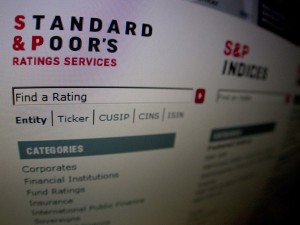S&P upgrades PH credit rating
The Philippines’ image got a boost Wednesday after Standard & Poor’s (S&P) raised the country’s credit rating by a notch, citing the government’s declining debt burden and other favorable developments on the economic front.
S&P, one of the major international credit rating firms, raised the country’s long-term foreign currency rating from BB to BB+, just one notch below investment grade.
Long-term foreign currency rating is one of the guides used by foreign investors in making investment decisions, such as whether or not to buy bonds sold by a government or do business in a country.
S&P assigned a “stable” outlook on the latest credit rating. This means the rating is likely to remain the same within about a year until a new review is done.
In a report released last night, S&P said its decision was based partly on the government’s improving debt profile.
Article continues after this advertisementOver the years, the government has gradually been trimming its debt burden—the proportion of its outstanding debts to the country’s gross domestic product (GDP)—through measures that improve tax and revenue collection.
Article continues after this advertisementThe debt-to-GDP ratio, one of the key indicators closely monitored by credit rating firms, improved from 84 percent in 2004 to only about 50 percent to date.
“The foreign currency rating upgrade reflects our assessment of gradually easing fiscal vulnerability, as the government’s fiscal condition improves its debt profile and lowers its interest burden,” S&P said.
Moreover, the credit rating firm cited the Philippines’ much improved level of foreign currency reserves, which it said made the country able to meet its liabilities to foreign creditors and bond holders.
Record reserves
The country’s reserves of foreign currencies, called the gross international reserves (GIR), reached a record high of about $77 billion earlier this year.
The GIR indicates a country’s wealth of foreign exchange and determines its ability to pay for imported goods, pay debts to foreign creditors and engage in other commercial transactions with the rest of the world.
The amount is enough to cover over 11 months’ worth of imports and is equivalent to about six times the foreign currency-denominated debts of government and private entities in the Philippines.
The country’s foreign exchange reserves have risen over the years, thanks to sustained growth in remittances from overseas Filipino workers, foreign investments in the country’s business process outsourcing sector and foreign portfolio investments.
“The rating action also reflects the country’s strengthening external position,” S&P said.
BSP pleased
Governor Amando Tetangco Jr. of the Bangko Sentral ng Pilipinas was pleased with the credit upgrade by S&P.
Tetangco said the move of S&P came with the improved appetite of foreign portfolio investors for peso-denominated stocks and bonds. Increased purchases of peso-denominated portfolio instruments led the peso to hit a four-year high of 41.72 to a US dollar on Tuesday.
He said the international financial community was recognizing favorable economic developments in the Philippines.
2nd fastest in Asia
In the first quarter of the year, the Philippine economy, as measured by the gross domestic product (GDP), grew by 6.4 percent from a year ago. This was faster than the 4.9 percent recorded in the same period last year.
The latest GDP growth of the Philippines was the second fastest in Asia for the first quarter after China’s 8.1 percent.
“We welcome the upgrade from S&P. The action of the market in the couple of days [that led to the appreciation of the peso] was a forth-telling,” Tetangco said in a statement.
The latest move by S&P makes its rating for the Philippines the same as that assigned by Fitch Ratings, its competitor.
Moody’s Investors Service, another major international credit rating agency and the most pessimistic about the Philippines, rates the country two notches below investment grade.
Philippine economic officials are pitching for improved credit ratings for the Philippines, claiming that the country’s economic fundamentals are in fact already comparable to those of some countries enjoying investment grade.
Indonesia, which the Philippines considers a contemporary, got an investment rating late last year.
Government economic officials said that an investment rating for the Philippines would help drive job-generating foreign direct investments, lift incomes, and reduce poverty.
Originally posted: 10:30 pm | Wednesday, July 4th, 2012
